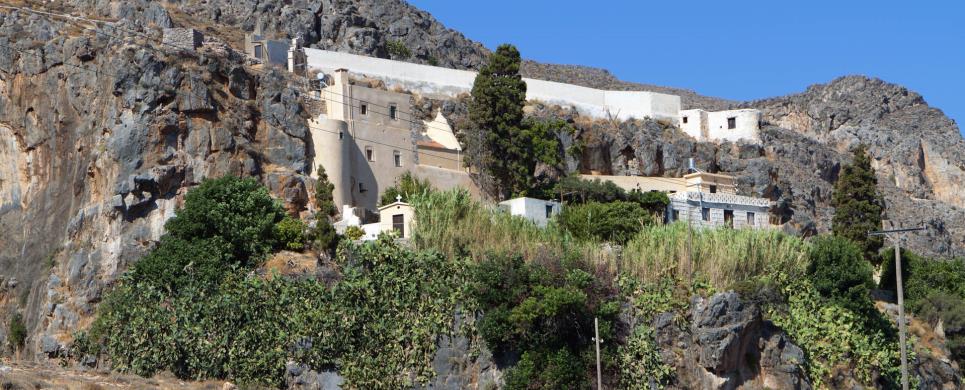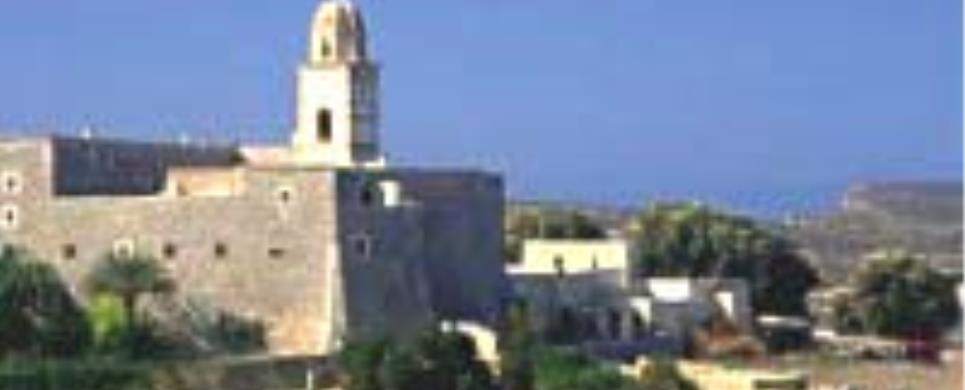Listed 17 sub titles with search on: Places of worship for wider area of: "SITIA Province LASSITHI" .
ARMENI (Village) LEFKI
In the village of Armeni is the Byzantine church of the Panagia with
relief decorations on the door.



AZOKERAMOS (Settlement) ITANOS
Before the entrance to the village there is the Byzantine church of
Agios Ioannis. The church is in the cemetery of the village on the left beside
the road and it has a unique carving above the door.






EXO MOULIANA (Village) SITIA
The fourteenth century Byzantine church of Afentis Christos (Metamorphosis)
is set picturesquely in the middle of a valley and has interesting, simple, but
sturdy architecture.



KATO EPISKOPI (Settlement) SITIA
There is the eleventh century Byzantine church of Agii Apostoli in
Kato Episkopi. The beautiful cemetery church, which as the name suggests, was
a bishopric church during the second Byzantine period, has an unusual rectangular
shape.



LITHINA (Village) MAKRYS GIALOS
The Byzantine church of Agii Apostoli containing well-preserved frescoes
from 1415 is in the area of Andromili. It is a single-aisled church with a narthex
on the side of the church and at right angles to it.



The Byzantine church of the Panagia in Lithines contains frescoes
which are unfortunately darkened by smoke, but has a collection of good icons.



The Byzantine church of Agios Athanasios has a number of decorative
plates and an inscription stating that it was renovated in 1587. Outside the church
is the tomb of a man named Vlatsos. The church also has an elaborate altar screen.



PANO EPISKOPI (Settlement) SITIA
It is older than the church of Agii Apostoli in Kato Episkopi and
appears to have been a three-aisled basilica originally. It has been renovated
many times and the church has lost its original form. Apparently the renovations
were done by the Venetian bishop, Vidiani.



ZIROS (Village) LEFKI
The area was occupied by Turks and a plot killed a number of local
men in the church of Agia Paraskevi. The bones of these men are on display in
the same church. Also in Agia Paraskevi is a fresco on the arch above the door
dated 1565.




MONI KAPSA (Monastery) MAKRYS GIALOS
Tel: +30 28430 51458
Fax: +30 28430 51458
Between Lithines and Makrigialos there are signs for the Kapsa Monastery.
The sign post at the sea indicates the most scenic route and affords an opportunity
to stop for a swim at one of the many coves. The Kapsa Monastery is 10km from
Makrigialos, about 35km from Ierapetra, on the south coast of Crete.
The fifteenth century monastery is located high on a cliff. The sanctuary of the
church is in a cave with the body of the church extending outwards.
The eccentric monk Gerontoyannis ("Old John") is buried here and the
locals revere him as a saint because he was known to have performed miracles and
cured the sick which lead to streams of visitors to the monastery. These pilgrimages
disturbed the Turkish authorities who arrested Gerontoyannis but later let him
go free. During the last years of his life, Gerontoyannis prayed in a small cave
above the church and the two small hollows on the cave floor were supposedly made
by the holy man's knees as he prayed.
This text is cited Mar 2003 from the Crete TOURnet URL below, which contains images.









TOPLOU (Settlement) LASSITHI
Tel: +30 28430 61226
Fax: +30 28430 61085
It is a historical monastery
of the 15th century, which collapsed in the earthquake of 1612 and was rebuilt with the financial aid of the Venetians. During the Ottoman
conquest of Crete, the monastery was destroyed and devastated by the Turks. In 1704 the monastery was declared stauropegion. During
the Ottoman occupation there was a school in the monastery, while, after 1870, it was founded there a school of mutual teaching.
The Monastery is enclosed by a fortress.
The main complex of 800 m2 has three floors, which are divided into cells, guest - houses, kitchens, the abbot's residense and warehouses.
The katholicon is a two-aisled church; the northern aisle is dedicated to the Virgin, and the southern posterior aisle, to St John the Theologian.
The monastery' s characteristic bell tower
bears relief crowns and crosses with inscriptions and the date 1558.
The 13th Ephorate of Byzantine Antiquities carried out works of consolidation and restoration.
In the Monastery, there is also an interesting Museum.
The monastery of Toplou is 16km east of Sitia, on the main road, and
is located on a small plain 160 metres above sea level. Toplou Monastery, or Akrotiriani
Monastery, is an important fortress monastery situated in the eastern part of
Crete. Although it is not known when the monastery started, there are various
documents and seals that point to its existence before the fifteenth century.
Throughout its long history, Toplou has withstood many attacks and occupations
by invading forces. This is partly due to its strategic position. Solidly-built
walls enclosed the monastery. Entry to the interior is through a massive, heavy
door on the western wall. High above the door is the "murderer's hole".
The monks or those who had found refuge inside poured boiling oil or water onto
the heads of the attackers. There was also a cannon to protect the monastery,
hence the name Toplou, Turkish for "with a cannon".
The monastery was a centre for revolutionary meetings and provided shelter for
freedom fighters during the Greek revolution of 1821. As a reprisal, the Turks
hung fourteen monks from the main gate.
During World War II, the monastery was again a place of resistance, this time
against the German forces. The abbot, Gennadios Syllingakis, assisted in the installation
of a wireless transmitter and from here messages were sent to Allied headquarters
in the Middle East. An English officer hid in the monastery and operated the wireless.
When the Germans learned of the activity here, they arrested the abbot and several
monks and later executed them all.
In addition to its noteworthy history, Toplou is famous today for its icon by
Ioannis Kornaros known as "Great Art Thou, O Lord". This depicts sixty-one
scenes from the Orthodox liturgy and dates from 1770. Many other very interesting
Byzantine icons are displayed in the monastery museum.
There is also an important inscription
on the left wall of the entrance to the church which is part of the Arbitration
of Magnesia (132 B.C.) referring to an alliance between Itanos and Ierapytna (see
Itanos). The slab was brought from Itanos for a tomb stone to be used later as
an altar in the small church of Timios Stavros across the road from the monastery.
The Englishman R. Pashley suggested its present position while travelling in Crete
in 1834, having recognised its importance.
The main monastery church is a double-aisled
basilica, consecrated to the Nativity of Our Lady and Agios Ioannis Theologos
(celebrating 8 and 26 September respectively). The church also contains some fourteenth
century frescoes on the north wall and a rare antique carved altar screen.
This text is cited Mar 2003 from the Crete TOURnet URL below, which contains images.









Receive our daily Newsletter with all the latest updates on the Greek Travel industry.
Subscribe now!